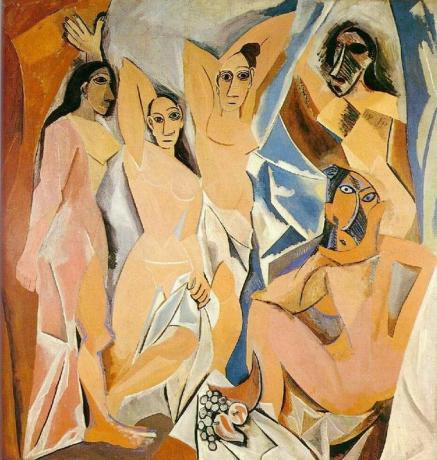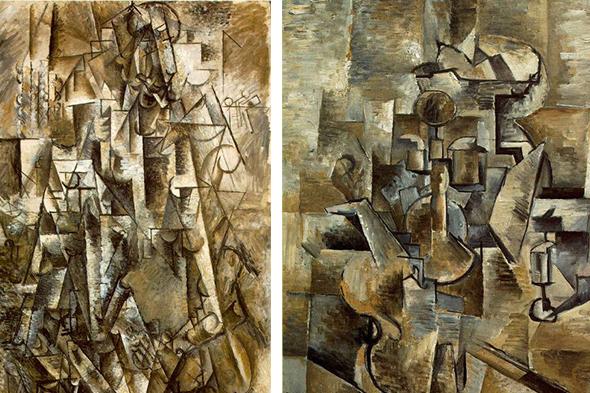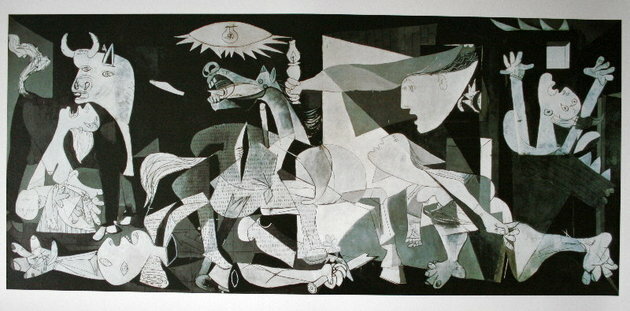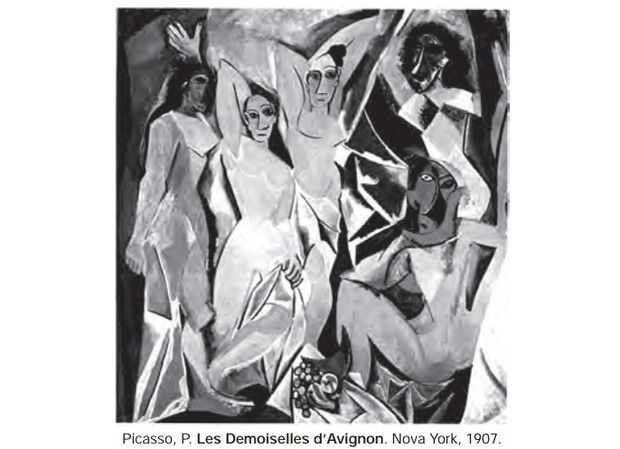Cubism was a European artistic avant-garde marked by the use of geometric forms. Emerging at the beginning of the 20th century in France, this new style broke with the aesthetic models that only valued the perfection of forms.
This movement can be considered the first to be characterized by the incorporation of industrial urban imagery in its works. It mainly covered the plastic arts and influenced literature.
Origin of Cubism
The milestone for the emergence of cubism was in 1907, with the canvas Les Demoiselles d'Avignon (The Ladies d'Avignon), by the Spanish painter Pablo Picasso.

This work shows visible influences from African sculptures and paintings by the French post-impressionist Paul Cézanne.
Alongside Picasso, the French painter and sculptor Georges Braque was also the founder of the Cubist movement.
Main Characteristics of Cubism
With cubism we will have a treatment geometric of shapes from nature.
Thus, they are represented by objects at all their angles on the same plane, constituting a three-dimensional figure.
Straight lines, basically modeled by cubes and cylinders, predominate, given the geometry of shapes and volumes.
This technique that renounces perspective as well as "bright-dark" causes a feeling of sculptural painting.
Conceptually, cubism can be considered an art that privileges the mental exercise as a way of expressing ideas.
To the break with perspective enshrined in the contour lines, nature is now portrayed in a simplified way.
This allows for greater abstraction about the aesthetic attributes of the work, while rejecting the idea of art as a pure imitation of nature. About this, Georges Braque stated:
You don't imitate what you want to create.
It is worth mentioning that this style abandons distinctions between form and ground or any notion of depth.
Themes such as urban still lifes and portraits are used by Cubist painters as resources to experiment and create based on the particularities of this aspect.
Cubism Stages
Cubism is divided into three phases:
Cezanne or Cezanian Phase (1907 to 1909)

Also called the pre-analytical phase, the name already indicates that this period was characterized by the influence of the works of the French plastic artist Paul Cezanne.
In this phase, the artists began their experiments with the simplification of forms and later started to represent the figures arranged in the same plane.
It was as if they were open on the screen, seen from the front by the audience.
Analytical or Hermetic Phase (1909 to 1912)

The analytical phase was characterized by moderate color, accentuating shades of brown, black, gray and ocher. This choice of colors was made because the most important thing was the display of the fragmented theme, arranged in all possible angles.
This crumbling of forms reached such high levels that, in the end, the figures became unrecognizable.
Synthetic Cubism Phase (1911)

Synthetic Cubism was characterized by stronger colors and a return to the figurative, as it sought to make the figures recognizable again, but without returning to a realistic treatment.
At this stage, the method of collage, fixing real objects on the screen, such as pieces of wood, glass and metal.
In addition, they introduced newspaper clippings with words and numbers. These resources were used in order to extrapolate the limits of the visual sensations that the painting insinuates, exploring the senses of touch as well.
Cubism and Science
At the beginning of the 20th century there was an admirable convergence of knowledge and interests from various fields of knowledge.
At that moment, art will place itself, especially with Cubism, in tune with cutting-edge scientific investigations taking place in physics and geometry.
When Cubism broke with centuries of prioritizing the use of perspective in pictorial representation, it ended up leading to geometric notions of hyper polyhedra and multidimensionality.
This allowed Cubist artists to formulate a hitherto unprecedented spatial concept, namely, the "fourth dimension". In it, the spatiotemporal properties are in affinity with Einstein's "Theory of Relativity" (1905).
Cubism in Brazil

In Brazil, only after the Modern Art Week 1922 is that the Cubist movement will gain strength.
Although Brazilian artists have not given themselves over to exclusively Cubist characteristics, it is possible to see clear influences from this trend.
The artist Tarsila do Amaral was some personalities who used cubist characteristics in her canvases. In them, we note the influence of this European avant-garde through the use of geometric shapes.
Still in the plastic arts, it is worth mentioning the works of other Brazilian artists: Anita Malfatti, Rego Monteiro and Di Cavalcanti.
Cubist literature in Brazil, on the other hand, was highlighted by the works of writers: Oswald de Andrade, Raul Boop and Érico Veríssimo. Note that Cubist literature has focused on the "destruction of syntax", putting an end to linearity.
Top Cubist Painters
The greatest representatives of cubist painting were:
- Pablo Picasso (1881-1973)
- Georges Braque (1882-1963)
- Juan Gris (1887-1927)
- Fernand Léger (1881-1955)
- Diego Rivera (1886-1957)
Top Cubist Sculptors
The greatest representatives of cubist sculpture were:
- Raymond Duchamp-Villon (1873-1918)
- Constantin Brancusi (1876-1957)
Top Cubist Writers
The main writers influenced by Cubism were:
- Guillaume Apollinaire (1880-1918)
- Jean Cocteau (1889-1963)
- Oswald de Andrade (1890-1954)
- Érico Verissimo (1905-1975)
- Raul Bopp (1898-1984)
Exercises on Cubism (Enem and Vestibular)
1. (Enem/2011)

The Spanish painter Pablo Picasso (1881–1973), one of the most valued in the artistic world, both in terms financial as well as historical, he created Guernica in protest of the air attack on the small Basque town of same name. The work, made to be part of the International Salon of Plastic Arts in Paris, traveled all over Europe, arriving in the USA and settling at MoMA, where it would only be released in 1981. This cubist work has plastic elements identified by:
a) monochromatic ideographic panel, which focuses on various dimensions of an event, renouncing reality, placing itself in a frontal plane to the spectator.
b) horror of war in a photographic way, with the use of classical perspective, involving the viewer in this brutal example of human cruelty.
c) use of geometric shapes on the same plane, without emotion and expression, unconcerned with volume, perspective and sculptural sensation.
d) crumbling of the objects covered in the same narrative, minimizing human pain in the service of objectivity, observed through the use of chiaroscuro.
e) use of several icons that represent two-dimensionally fragmented characters, in a photographic way free of sentimentality.
The correct answer is the alternative a) monochromatic ideographic panel, which focuses on various dimensions of an event, renouncing reality, placing itself in a frontal plane to the spectator.
The Cubist movement prized the display of fragmented forms, placing the elements of the scene in all possible angles, which gives the idea of various dimensions within the canvas. Thus, there is a refusal to realistic representation.
Answer B is incorrect as there is no photographic representation on the screen, nor classical perspective. On the contrary, there is a break with such patterns.
Answer C says that there is no emotion and expression in the painting, which is a mistake. You can notice intense emotion in the characters' expressions. In addition, there is a concern with sculptural forms and feel, as in the entire Cubist movement.
In answer D, there is an error in stating that the work "minimizes human pain" in the service of objectivity, since, as mentioned, human pain is precisely evidenced. The same is suggested by alternative E, which says there is an absence of sentimentality.
2. (Enem/2012)

The painting Les Demoiselles d'Avignon (1907), by Pablo Picasso, represents the break with classical aesthetics and the revolution in art at the beginning of the 20th century. This new trend is characterized by:
a) painting of models in irregular planes.
b) women as the central theme of the work.
c) scene represented by several models.
d) opposition between light and dark tones.
e) nudity explored as an art object.
The correct alternative is a) painting models in irregular planes.
Cubism's main characteristic was the representation of figures in various planes, seeking to achieve a "three-dimensionality" in painting, displaying shapes in irregular planes.
The theme was not necessarily women or nudity. So, as not concerned with the opposition of light and dark tones. Scenes could also display one or more models in addition to objects.
3. (Unifesp/2018)
Such avant-garde radically broke with the idea of art as an imitation of nature, prevalent in European painting since the Renaissance. Its main adherents have abandoned traditional notions of perspective,
trying to represent solidity and volume on a two-dimensional surface, without converting the flat canvas into a three-dimensional pictorial space by illusion. Multiple aspects of the object were figured simultaneously; the visible forms were analyzed and transformed into geometric planes, which were recomposed according to several simultaneous points of view. Such avant-garde was and claimed to be a realist, but it was a conceptual realism, not an optical one.
Ian Chilvers (org). Oxford Dictionary of Art, 2007. Adapted.
A representative painting of the avant-garde to which the text refers is reproduced in:

The correct answer is the letter a) The Ladies of Avignon, by Pablo Picasso.
This work is considered a milestone in the Cubist movement.
As for the other alternatives:
- The canvas that appears in alternative B is O Grito, by Munch, the precursor of the expressionist movement.
- In the letter C, the screen shown Luminárias Vermelhas, by Roy Lishteinstein, is part of the movement called pop-art.
- In alternative D, René Magritte, author of the picture Império das Luzes, exhibits a surrealist work.
- In the letter E, Violinista à window appears, painted by Henri Matisse, one of the artists of Fauvism.
Also check out this selection of questions that we have separated for you to test your knowledge: Exercises on European Vanguards.
To learn more about other strands of European vanguards, read:
- Expressionism
- Impressionism
- Fauvism
- futurism
- Surrealism
- Dadaism
